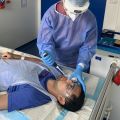University of Oxford uses AI to detect antibiotic resistance faster than gold-standard testing
21 November 2023
To mark World Antimicrobial Awareness Week, researchers supported by the Oxford Martin Programme on Antimicrobial Resistance Testing (University of Oxford) have reported advances towards a novel and rapid antimicrobial susceptibility test that can return results within as little as 30 minutes.
In their study published in Communications Biology, the team used a combination of fluorescence microscopy and artificial intelligence (AI) to detect antimicrobial resistance (AMR). This method relies on training deep-learning models to analyse bacterial cell images and detect structural changes that may occur in cells when they are treated with antibiotics. The method was shown to be effective across multiple antibiotics, achieving at least 80% accuracy on a per-cell basis.
The researchers say their model could be used to identify whether cells in clinical samples are resistant to a range of a wide variety of antibiotics in the future.
Co-author of the paper Achillefs Kapanidis, Professor of Biological Physics and Director of the Oxford Martin Programme on Antimicrobial Resistance Testing, said:
‘Antibiotics that stop the growth of bacterial cells also change how cells look under a microscope, and affect cellular structures such as the bacterial chromosome.’
‘Our AI-based approach detects such changes reliably and rapidly. Equally, if a cell is resistant, the changes we selected are absent, and this forms the basis for detecting antibiotic resistance.’
The researchers tested their method on a range of clinical isolates of E. coli, each with varying levels of resistance to the antibiotic ciprofloxacin. The deep-learning models were able to detect antibiotic resistance reliably and at least 10 times faster than established state-of-the art clinical methods considered to be gold standard.
The team hopes to continue developing their method so that it becomes faster and more scalable for clinical use, as well as adapting its usage for different types of bacteria and antibiotics.
According to the Global Research on Antimicrobial Resistance (GRAM) Project – a partnership involving the University – almost 1.3 million people died in 2019 due to AMR.
Current testing methods rely on growing bacterial colonies in the presence of antibiotics. However, such tests are slow, often requiring several days to understand how resistant bacteria are to a range of antibiotics.
This can be problematic when patients have potentially life-threatening infections, such as sepsis, requiring urgent treatment. This usually forces doctors to either prescribe specific antibiotics based on their clinical experience or a cocktail of antibiotics known to be effective across multiple bacterial infections. However, if ineffective antibiotics are prescribed the patients’ infections may get worse and they will need to be treated with more antibiotics. One potential outcome of this is increased antimicrobial resistance to antibiotics in the community.
The researchers say that if developed further, the rapid nature of their method may facilitate targeted antibiotic treatments – helping to decrease treatment times, minimise side effects, and ultimately slow down the rise of AMR.
Co-author of the paper Dr Piers Turner, Postdoctoral Researcher with the Oxford Martin Programme on Antimicrobial Resistance Testing and the University’s Department of Physics, said:
‘In an era where antimicrobial resistance poses a critical public health threat, our team has made a ground-breaking advancement toward rapid detection of antimicrobial resistance. This innovation may hold the potential to revolutionise the way we respond to infectious diseases, allowing for more precise and timely treatment decisions, ultimately saving lives.’
Co-author of the paper Aleksander Zagajewski, doctoral student with the University’s Department of Physics, said:
‘Time is beginning to run out for our antibiotic arsenal; we are hoping our novel diagnostics will pave the way for a new generation of precision treatments for the most sick patients.’
Researchers from across the University contributed to the study, including from the Department of Physics, Nuffield Department of Medicine, Sir William Dunn School of Pathology and Nuffield Department of Women’s Reproductive Health. Researchers from the Oxford University Hospitals NHS Foundation Trust’s Department of Microbiology and Infectious Diseases were also involved.
The paper ‘Deep learning and single-cell phenotyping for rapid antimicrobial susceptibility detection in Escherichia coli’ can be accessed here: https://www.nature.com/articles/s42003-023-05524-4
Notes to Editors
For an interview with the researchers or further information, please contact Amjad Parkar on [email protected]
About the Oxford Martin School Programme on Antimicrobial Resistance Testing
The Oxford Martin School Programme on Antimicrobial Resistance Testing aims to develop rapid tests that can both identify bacterial species and establish which antibiotics they are susceptible to, in as little as 30 minutes. Part of the problem at present is that bacteria must be isolated and cultured within labs, leading to bottlenecks in testing.
The programme intends to enable direct testing of clinical samples, using ultrasensitive microscopy tests, sophisticated image analysis and machine learning, hugely speeding up the process by which clinicians obtain the information they need. It will enable precise and personalised treatment of infections with narrow spectrum antibiotics, reducing the unwarranted use of broad-spectrum antibiotics.
About the Oxford Martin School
The Oxford Martin School is a world-leading research department of the University of Oxford. Its 200 academics work across more than 30 pioneering research programmes to find solutions to the world's most urgent challenges. It supports novel and high-risk projects that often do not fit within conventional funding channels, with the belief that breaking boundaries and fostering innovative collaborations can dramatically improve the wellbeing of this and future generations. Underpinning all our research is the need to translate academic excellence into impact – from innovations in science, medicine, and technology, through to providing expert advice and policy recommendations.
About the University of Oxford
Oxford University has been placed number 1 in the Times Higher Education World University Rankings for the eighth year running, and number 3 in the QS World Rankings 2024. At the heart of this success are the twin-pillars of our ground-breaking research and innovation and our distinctive educational offer.
Oxford is world-famous for research and teaching excellence and home to some of the most talented people from across the globe. Our work helps the lives of millions, solving real-world problems through a huge network of partnerships and collaborations. The breadth and interdisciplinary nature of our research alongside our personalised approach to teaching sparks imaginative and inventive insights and solutions.Through its research commercialisation arm, Oxford University Innovation, Oxford is the highest university patent filer in the UK and is ranked first in the UK for university spinouts, having created more than 300 new companies since 1988. Over a third of these companies have been created in the past five years. The university is a catalyst for prosperity in Oxfordshire and the United Kingdom, contributing £15.7 billion to the UK economy in 2018/19, and supports more than 28,000 full time jobs.
 Ground-breaking study reveals how COVID-19 vaccines prevent severe disease
Ground-breaking study reveals how COVID-19 vaccines prevent severe disease
 Novel triple drug combination effective against antibiotic-resistant bacteria
Novel triple drug combination effective against antibiotic-resistant bacteria
 Researchers discover how immune cells hunt down cancer around the body
Researchers discover how immune cells hunt down cancer around the body
 New algorithm supercharges climate models and could lead to better predictions of future climate change
New algorithm supercharges climate models and could lead to better predictions of future climate change
 New study to improve vaccines and therapeutics development
New study to improve vaccines and therapeutics development